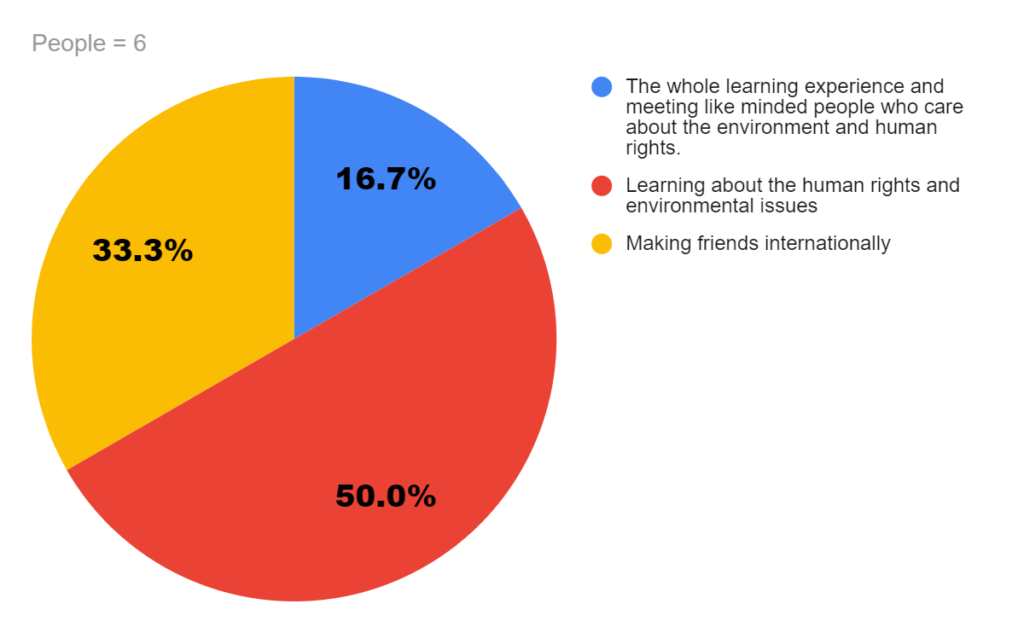How would we describe the project in one word?

Why did we decide to participate in the project?
As you can see from these quotes from our team, there are a variety of reasons why we got involved in the project. On one hand, it was an opportunity for a social experience in these times of the pandemic. On the other hand, there was the serious business of learning about and contributing to the campaigns fighting for human rights and environmental justice. To be able to make connections with the students from Mexico and with Trócaire was an opportunity too good to pass up!
“I chose to participate in this project because I wanted to meet new like-minded people and learn how I could help make an impact in the fight against human rights abuses and the environment. It was an amazing opportunity that was too good to pass.” (Mary McNicholas)
“For the experience” (Karina Isabel Miros Toto)
“I personally chose to participate since I wanted to learn more about the abuses in the Americas, be more globally informed, and make more international connections.” (Liam O’Leary)
“Mainly, to get the opportunity to meet students from Mexico (in a time where meeting new people is almost impossible!) and to work with Trócaire, an organisation which is renowned for the work they do both nationally and internationally.” (Lucy Creedon)
“To gain a better insight into the policy aspects of social justice issues.” (Mark Hartery)
“I jumped at the opportunity to work with Trócaire and learn about this important social justice issue.” (Catherine O’Sullivan)
“I mainly wanted to gain insight into human right abuses in other parts of the world. I was also excited to meet new people and learn from all the people involved” (Lucia Garcia)
“To get an international perspective on important issues” (Ciara Georgina O’Dwyer)
What was our favourite part of the project?
Mary McNicholas – “I found the whole process of the project an amazing experience and was lucky to have spent it with amazing people. Thankful for the opportunity to be part of such a fantastic group!”

If we could start again, what would we do differently?
Overall, the team were happy with how the project went. On the night of the webinar, there was a great sense of pride and satisfaction in what we had carried out. Everyone was in good spirits and the audience seemed to enjoy it. It all came together in the end!
However, there is always room to improve and there are a few things that might have made the project a little bit better. The beginning seems to be the point where the most changes could be made. There were some problems with cohesiveness and balance at the beginning. We were not entirely sure where to take the project and we struggled with our communication with the Mexican students. Also as Lucy suggests, maybe some deeper reading and learning on human rights, the environment and Big Business before the meetings started would have enhanced the project.
Despite these struggles, with the leadership of Mary, the translations and collaboration by Eduardo and Daria, and the helpfulness and initiative of the whole team, we managed to make it a successful project.
“I don’t think I would do anything differently. I enjoyed the whole process and the people involved.” (Mary McNicholas)
“The organization in Teams” (Karina Isabel Miros Toto)
“I would structure our first weeks quite differently, for a while the project was dominated from one side and I felt it wasn’t as inclusive as it could’ve been. An initial more casual introduction to the Mexican participants would have led to more unity at those early weeks I think.” (Liam O’Leary)
“I would have read up on the issues we tackled beforehand in order to get the most out of the project, though I still learned a lot.” (Lucy Creedon)
“Very little, I’m really happy with how we all worked together and how everything came together.” (Mark Hartery)
“I would create more balance between the Irish and Mexican students. Translating and knowing what we were doing was challenging at the beginning. Maybe brush up on my Spanish, too!” (Catherine O’Sullivan)
“I would design a better system to share our ideas and communicate with each other in general. Other than that I really enjoyed the process and wouldn’t change anything” (Lucia Garcia)
“Probably ensure a stable wi-fi connection, and maybe participate in the presentations.” (Ciara Georgina O’Dwyer)
| Anne’s Analysis (by Anne Barrett) The educational development process was most effective in the following ways: 1. Interaction in chat rooms: working together on offering solutions to set questions was a beneficial way of getting to know the knowledge and training of others and finding where skills can combine. The most enjoyable part was collaborative interaction on projects. 2. Working on our project was the next enjoyable part. Practical application of skills in a creative way is a good way of retaining what is learned. 3. The teaching methods are very interesting in that they are very interactive and seem to operate without hierarchical structures. This seems to be very much how educational training is most effective. 4. The speakers brought in to offer insights were enriching to listen to and helped broaden perspectives. |